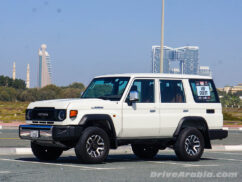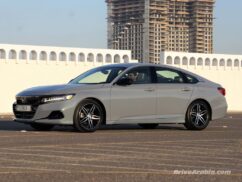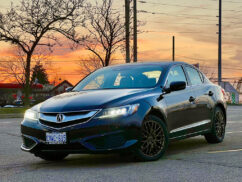2005 Honda MR-V

| The Good: – Reliable and solidly built – Roomy interior – Decent acceleration | The Bad: – Lifeless steering – Dull styling – Tight third row seat |
The Honda MR-V is a reasonably priced, practical 4WD vehicle that is Honda’s biggest vehicle yet. It is powered by a high-revving V6 engine, equipping it with a decent amount of performance for a 4WD, and it carries on for the 2005 model year with minor changes which improve its utility.
The MR-V is regarded as the Honda of 4WDs. It features practicality, efficiency and reliability. Power is provided by a 240 hp 3.5-litre V6 engine paired with a five-speed automatic transmission and an advanced four-wheel-drive system. It drives more like a car rather than a truck. It is also equipped with the typical predictable handling for which all Hondas vehicles are well known.
Capable of seating up to eight passengers, the MR-V is not a petite vehicle. Here in the Middle East it competes against the Ford Explorer, the Toyota Prado and the Nissan Pathfinder.
The MR-V is available in two trims. The LXi comes with air conditioning, cruise control, AM/FM/CD stereo, power windows, mirrors and door locks, and a rear wiper. Standard safety features include anti-lock brakes, front-passenger frontal and side-impact airbags. The EXi adds a sunroof and a leather interior. The EXi can be easily distinguished from the LXi as it is equipped with 16-inch aluminium alloy wheels and body-colored moldings, mirrors and door handles.
The MR-V elegantly borrows key styling cues from Honda’s smaller 4WD, the CR-V. The grille and headlights are a direct enlargement of the CR-V’s front. A large Honda badge on the front show grille make it clear Honda is very proud of it, and wants customers to feel the same way. All in all, the styling is inoffensive and nothing remarkable.
The MR-V can settle up to eight, but some of them better be small. The second-row seats are comfortable for adults, but the third-row seats are better for kids only. Similar to the CR-V, rear seats are slightly higher than those ahead, thus needlessly improving forward visibility for passengers. The second-row seatbacks recline, within a limited range. The second row can slide fore and aft, allowing leg room for the second row and tight third row to be adjusted according to the desire of the passengers.
Honda equipped the MR-V with an enormous dial in the middle of the instrument panel, enabling easy viewing. The other instruments and controls will be familiar to anyone who has driven a Honda. Honda seldom varies these basics, which for decades have proven to be so successful. It consists of a minivan-like column shifter, which is spindly and moves in an ovoid path. There is a thin, sliding plastic lid over the center console which works fine, but is not very aesthetically appealing. However the fold-out cell-phone holder with a power outlet seems like a nice feature, but blocks out the two cupholders in front of it. Nevertheless, the console provides plenty of storage space in a compartment behind the cell-phone holder. A covered compartment located below the MR-V’s center stack provides more storage space between the console and the instrument panel.
The Honda MR-V comes with child-friendly features. The LXi comes with cupholders for every seat and the EXi includes a second-row fold-down activity tray and even more cupholders and storage for pocket-sized items. There is the option of accessorizing the MR-V with a seven-inch DVD screen, which doesn’t take up much space when not in use. It’s easily viewed from all of the rear seats when deployed from the top headliner. Audio and video input jacks are provided for different electronic accessories such as camcorders, portable VCRs and game consoles. The system also includes two sets of wireless headphones, and jacks for three more wired headsets.
Overall finishing of the car is that of a typical Honda, even right down to the new-car smell of freshly molded plastics. There’s nothing luxurious about the MR-V’s interior. The panels match precisely throughout, and the materials, including cloth upholstery, are of superior Honda standards. The heavy MR-V is propelled by a 240 hp 3.5-litre V6 engine. Acceleration is excellent for a 4WD, particularly in the 50-100 kph range that matters most in daily usage. The MR-V beats the V6-powered Lexus RX330 in horsepower. More importantly, the engine produces 328 Nm of torque from 3000 to 5000 rpm, which is slightly more than the Toyota V6 in the Lexus. The huge 4.2-litre six-cylinder engine in the Chevrolet Trailblazer produces 275 hp and 360 Nm of torque, but is based on a truck chassis and is about 80 kg heavier than the MR-V. They are not as fuel efficient as the MR-V and are not equipped with anything as fancy as Honda’s five-speed automatic transmission. The Honda engine which is employed in the MR-V features a broad and flat torque curve, very low emissions and decent fuel economy. The MR-V’s five-speed automatic transmission shifts smoothly and precisely, even under hard acceleration. It uses the Honda’s Grade Logic Control system, which monitors throttle position, speed and acceleration to avoid hunting between gears. The transmission’s computer controller holds lower gears longer than normal for better performance going up hills, or to provide engine braking on downhill grades. Fourth and fifth gear ratios have been revised for 2005 to improve fuel efficiency.
The MR-V’s steering provides good feel and adjusts the firmness of the power-assisted steering wheel smoothly as it accelerates. The steering wheel turns effortlessly for driving in parking lots and tight driveways. However, the steering does not provide enough feedback when taking on twisty roads, and feels rather lifeless even when it firms up slightly at speed. On the whole the drive compares better to midsized cars than to truck-based 4WDs. The MR-V is very stable at high speeds, as well as in slow drives around tight roads. Passengers in the second-row seats found the ride equally comfortable, however the third-row passengers suffered a bit, as they were right above the rear wheels of the vehicle.
The MR-V’s all-wheel-drive system does not have low-range gearing necessary for it to become a proper offroader, but to make up for this deficiency, there is a dashboard button to split power evenly front to rear for rocky situations.
Unlike its competitors, the MR-V has enough sound insulation to prevent bumpy rides from being transmitted to the interior as noise. The anti-lock brakes (ABS) performed well in hard stops. The braking response is linear and smooth, providing a reassuring feel of total control.
The Honda MR-V is a well-priced, pleasant-looking 4WD that lives up to the expectations one has formed for a Honda vehicle. It offers exceptional interior space, luxury, comfort and good power. It brings Honda values and a reputation for reliability to the medium-size SUV class.






There are no comments. Be the first!